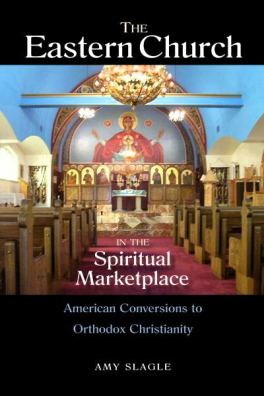
The Eastern Church in the Spiritual Marketplace (Northern Illinois University Press), by Amy Slagle of the University of Southern Mississippi, studies both the motivations of the converts and the impact they make on parish communities.
Slagle interviewed 48 converts and studied two parishes in Pittsburgh and Jackson, Mississippi. She finds that the potential convert discovers Orthodoxy through a process of searching and choice. The converts value the sense of community and the liturgical life of Orthodox Christianity, which they claim provides more freedom than the perceived “legalism” of Western Christianity. One of the parishes studied was described as “seeker-friendly” by its new members in the way it reached out to outsiders by means of evangelism and the Internet.
The converts also tended to select practices, such as opposition to kneeling and installing pews, as being more “pure” and theologically correct, even if they clashed with the everyday reality of ethnic Orthodox parish life. Most of the converts reported psychological benefits and heightened spiritual awareness in their new religious life, reflecting the importance of therapeutic values in society, according to Slagle.
Since intermarriage is based on the trend of many young Americans to marry those outside of their own faith, those converts who married an Orthodox spouse also adopted the faith through personal choice, although there was less emphasis on seeking and exploring in the spiritual marketplace in their accounts of conversion, according to Slagle. At the same time, those who converted through marriage to an ethnic Orthodox member valued the unified ethnic-religious identity they found for their marriages and families.
The main conflicts the converts face stem from the ethnic nature of Orthodoxy and, in some cases, the sense of exclusion they feel from cradle (Slavic and Greek) members of these churches. But alienation is far from the whole story, as many of the converts admire and even identify with the deep “roots” they found among parishioners, even if it means exploring their own non-Slavic or Greek ethnicities. For instance, from her exposure to the ethnic component of her Orthodox parish, one convert was encouraged to explore the roots of her Irish background and discover Celtic Christianity and its similarities to Orthodoxy.
As for the parishes, Slagle finds that they reported positive benefits from the presence of Orthodox converts, particularly in the way they infused spiritual enthusiasm and devotion into churches. Some lifelong members, however, expressed some concern that converts may not be prepared for the rigor of Orthodox observance.
Slagle pays special attention to the regional differences between the Orthodox situation in a predominantly non-Orthodox state such as Mississippi and that of the Pittsburgh area, which has been considered the “Holy Land” of Orthodoxy in the United States. The Orthodox from Mississippi did not see their faith as alien from the strong religious culture marking their state and the rest of the South. In fact, they often drew on their Southern evangelical sensibilities in talking about Orthodoxy. As one convert said, “…Everyone should be Orthodox. I want to preach to the Delta. The fields are ripe for harvest. We have this Christ-haunted culture in the South.”
Richard Cimino